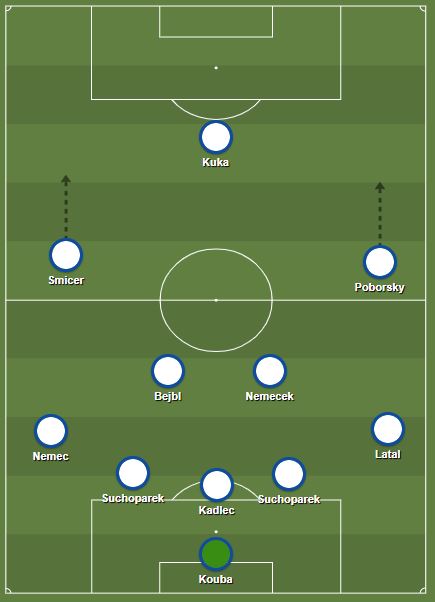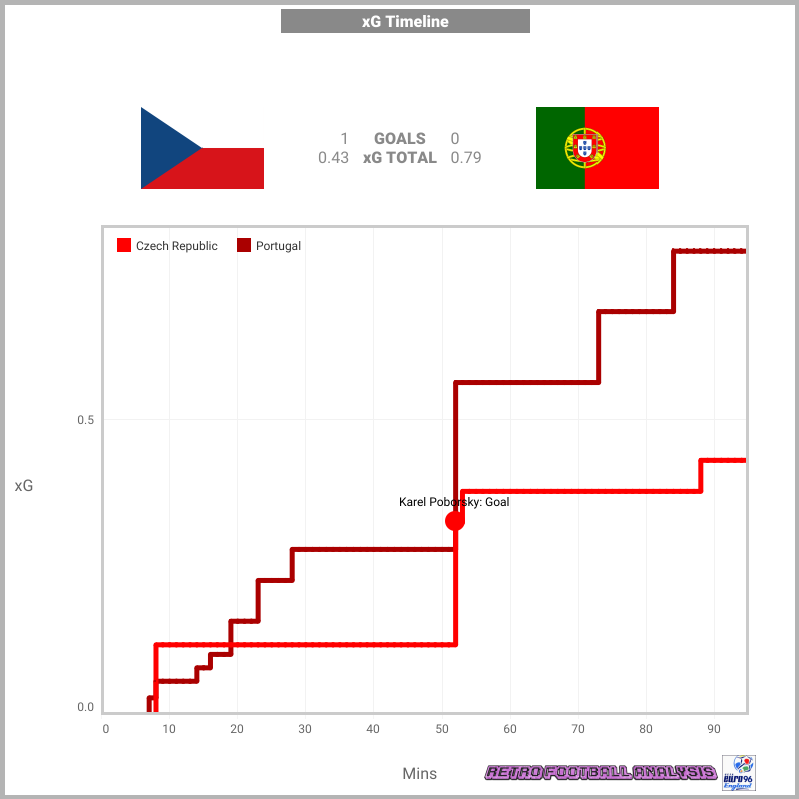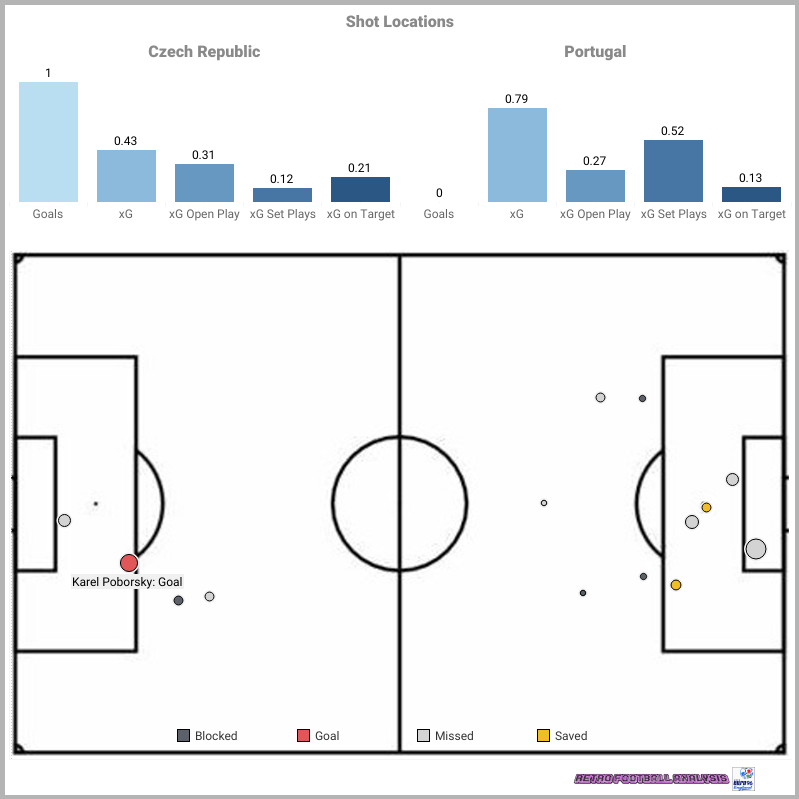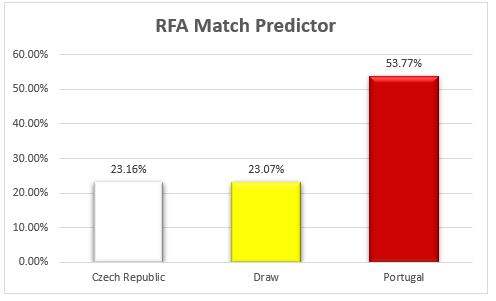Portugal would continue from where they left off last match, setting up in a 442 with a diamond midfield and no changes to the starting line up.
Sa Pinto’s movements would take him more to the right wing area, and similarly Joao Pinto would do the same on the left side.
Rui Costa had to work extremely hard to find space against the packed midfield that the Czech’s placed around him, therefore relying more on his close control and combination play.
The power of Oceano to carry the ball forward was important for Portugal, offering something different against an often static zonal Czech republic press that at times swallowed up Portugal.
Figo links the game on the left hand side, but also has license to dift over to the right and create overloads which allow a switch of play out to Dimas who stretches play on the wings.
Secretario offered a similar movement to Dimas, but with Sa Pinto & Oceano occupying the right side did so in a more supportive role from deep.
Portugal Starting X1

Czech Republic set up in a 523 system in attack, which would morph into a 541 in defensive phases.
Nemec and Latal covered the wide areas much like traditional full backs, only offering attacking support should they have secured possession and could move forward as a group.
Bejbl and Nemecek screened the back line and much like the wing backs would offer themselves in attack should the opportunity be there to do so without risking defensive stability.
Smicer and Poborsky were given license to break forward in counter attacking situations to assist Kuka. Poborsky was set up as the target for much of their early forward play, with Smicer pulling inside to narrow the attack when crossing opportunities on the right presented themselves.
Czech Republic Starting X1

WHAT DO THE NUMBERS TELL US?

Value of Chances
xG Timeline:
The flow of this match was in large part centered around Portugal and their inability to breakdown a Czech side who remained fully focused on controlling the space in their defensive third. Around the moment of the Czech goal they had actually brought themselves level in terms of attacking potency, however the second half would see Portugal increase the overall xG but in reality their threat probably weakened as the match went on.
Chance Quality:
The Czech’s were naturally very liberal with their attacks, so they had to be more selective in where & when to shoot on goal to maintain their level of probability and give themselves the best chance of scoring. Their goal fell into an opportune situation, so actually scored well in terms of xG, however its outcome was certainly less than conventional.
The Portuguese attacks on the whole failed to move the needle, with only 3 of their efforts scoring over 10% probability. They would only create 1 big chance in the game, a header inside the box from Cadete in the closing 10 minutes, but out with this opportunity there really wasn’t many efforts, statistical or otherwise, that you felt truly warranted a goal.
Type of Chances Created

The assist locations map is probably the most damning part of this report on the Portuguese, as it illustrates how poorly they used the ball when entering the final third. From the first whistle to the last the ball movements from the Portuguese were fluid, they showed control and dominated large parts of the Czech Republic half and overall territory. Despite all of the ball control they enjoyed, they simply failed to generate any problems for the Czech’s to deal with, and in the end had resorted to slinging hopeful balls into the box as their 5’10 forwards were outnumbered and outmaneuvered by the defenders in the middle of the box. Portugal’s lack of counter attack threat was the most puzzling element of their attack as it was absolutely non-existent. Coach Artur Jorge altered the teams forward press, asking the attackers to drop off in an attempt to encourage the Czech’s to bring the ball out. Even when that happened, and a turn over occurred, there was never enough penetration or runs in behind the opposition defense, that would trouble the Czech’s solid back line. What’s strange is that they had created 12 shots from counter attacks in their previous 3 matches, against stubborn defenses in each of them, so they certainly had the quality and wherewithal to hurt the Czech’s had they fulfilled their potential.
While it was clear what the Czech’s had come to do, and they were extremely good at doing it, as a staff they will have to look at more ways in which to create attacks. To only create 2 of the 4 attacks they registered isn’t form that will last you the duration of a knock out competition, so it will be interesting to see how the coach builds upon his very strong defence, perhaps looking to create more from set plays or advance their defensive unit higher up the field so transitions are closer to the goal.
Where Chances are Created

Much in the same way that the chance creation graph was a tough read for Portuguese followers, this shot map doesn’t make for much better viewing. While we have doubted Portugal’s striking potency throughout the tournament, especially their ability to convert big chances when it mattered, to return only two shots on target for a side that has the level of creative talent they have is well below par. Of their 10 attacks only 3 shots on goal would occur after the Czech’s goal, all of which missed the target completely, which for a side that is chasing the game to stay in a tournament shows a real lack of creativity and invention. There is an argument that they tried too hard to work the perfect chance or create the most beautiful goals, but in the professional game style points don’t count. When it was required of Portugal to find a goal by any means they simply didn’t have the fire power or the Plan B required to deliver it. Of their 0.79 xG only 16% of this value came from attacks that tested the goal keeper, and better yet over half the xG came from attacks from set plays, which again is completely contradictory to what Portugal see themselves as being about.
Who Created Chances
Portugal didn’t have many stand out statistical performers in this match, so I am going to award this to Fernando Couto who with two shots on goal and a single shot on target (0.18 xG) would come in as Portugal’s most potent attacking threat.
The best statistical attacker for the Czech Republic has to be Karel Poborsky. Delivering what would become a highly memorable goal to win the game, his stats show us he would score his only attack and create two more for his teammates.
Match Predictor
Using our very own Retro Football Analysis Match Simulator, we use the probability rating of each attack to calculate the odds of the matches outcome. Here are the results we got back.

Our verdict:
A highly unsurprising outcome here given Portugal’s higher attacking aggregate in the match, and qualified further by the Czech’s lack of attacks. Portugal did not deserve to advance through this round given their performance in 90 minutes, perhaps if the match stretched into extra time it could have been different, but the Czech’s defended for their lives and deserve to advance.


